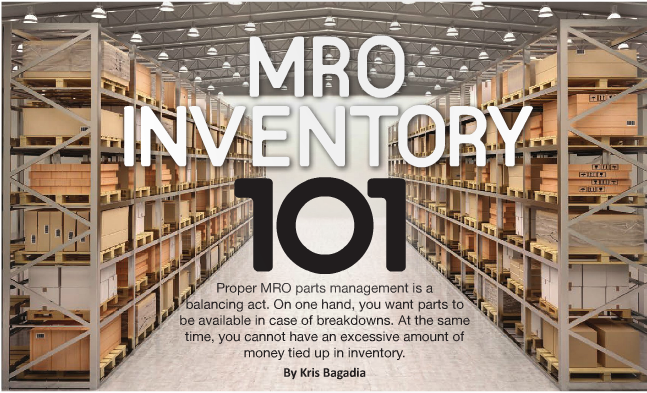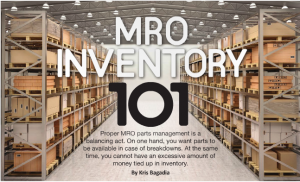
MRO Inventory 101
Proper MRO parts management is a balancing act. On one hand, you want parts to be available in the case of breakdowns. At the same time, you cannot have an excessive amount of money tied up in inventory.
August 15, 2016 | By Kris Bagadia

 Effective MRO parts management is crucial to maintenance productivity and reliability. If equipment is down and a required part is unavailable, that breakdown could cost you a tremendous amount of money because until the equipment is fixed, revenue is lost. Sometimes the part is in the storeroom, but you can’t find it; so you have to go through the process of locating a vendor, finding the part and ordering it. You’re losing a lot of money despite the part being there. Properly managing MRO inventory has proven time after time to save 10 – 30% of annual inventory dollars.
Effective MRO parts management is crucial to maintenance productivity and reliability. If equipment is down and a required part is unavailable, that breakdown could cost you a tremendous amount of money because until the equipment is fixed, revenue is lost. Sometimes the part is in the storeroom, but you can’t find it; so you have to go through the process of locating a vendor, finding the part and ordering it. You’re losing a lot of money despite the part being there. Properly managing MRO inventory has proven time after time to save 10 – 30% of annual inventory dollars.
Quality versus price
When locating parts, you want to ensure that you select a quality part at a reasonable price. There are a couple of ways that this can be accomplished.
Scenario One: Brand Name Or Generic
Just like pharmaceuticals, the costs of generic parts are much lower than brand-name parts. In fact, one can often find the same part for a fraction of the cost under a generic name. The key for the MRO buyer is to focus on the specifications (HP, RPM, frame size, etc.) of the required parts. This allows the MRO buyer to comparison-shop the parts in order to find the ones that meet the specifications at the cheapest prices.
Scenario Two: Quality Of Part
Although the low price of a part can be appealing, it may not always be the best choice in the long run. For instance, a construction company was using diamond cutters that cost $500 each. These utters were poor quality and needed to be replaced every week. The MRO buyer decided to seek alternatives and eventually found a higher-quality cutter for $1,200. Although the higher-quality cutter was more than twice the price of the original, it lasted six times longer. This initial cost yielded a savings of approximately $1,800 over the six weeks.
The above scenarios illustrate that the MRO buyer needs to think outside of the box when buying parts in order to find ways to cut costs and still maintain the quality.
Purchase material in the right quantity
MRO buyers are notorious for randomly determining the quantity of parts to order. Some companies issue a policy to order a spare of every part ordered as a way to ensure that the part is on hand if it is needed. While this accomplishes one task, it results in an excessive amount of money tied up in inventory. If you overstock, you lose a lot of money. If you understock, you can have increased breakdowns, and the delay in procuring a part can result in a tremendous amount of monetary losses.
But the overstock/under-stock situation can be avoided. Based on lead time, parts usage history and consequences of not having the part when needed, one can determine re-order points and appropriate quantities to purchase.
Receive material at the optimum time
If the storeroom and inventory are well organized and re-order points are used, plants generally will do very well. Unfortunately, this is not the case in many operations.
Material Shipping
Many operations are operating in a reactive mode where parts are usually rush-ordered as needed. This expedited shipping can result in excessive costs that may go unnoticed as long as the company is still profitable. These are often the companies that end up going under.
But with a Just-In-Time system, the ordering of the part is scheduled so that it arrives shortly before it is needed. This is relatively easy for manufacturing because one can better schedule for when the parts are needed. Unfortunately, maintenance operations cannot schedule for an equipment breakdown. However, the concept of “Just-in-Time” applies to preventive maintenance and other planned tasks. For example, if preventive maintenance calls for filters to be changed on air-handling units, the filters can be ordered so that they arrive shortly before they are needed rather than being ordered far in advance and then stocking up. Space is saved and excess money is not tied up in inventory.
The actual cost of issuing a purchase order
Many people overlook the fact that it costs money both to process and to issue purchase orders (POs). These costs come from labour (preparing PO, reviewing PO, approving PO, receiving and stocking parts, etc.), shipping costs and overhead for all related departments. We have seen costs as low as $30 but as high as $500 to issue a PO.
The MRO buyer usually issues POs as soon as parts are requested. At the end of the day, the buyer may have issued 10 POs. If each PO costs $300, this is a total cost of $3,000. Every storeroom or MRO buyer should be aware of the fact that POs cost money and should know exactly how much they cost.
It is not that POs should not be issued; they should be consolidated. If they are not urgent, which they usually shouldn’t be (as this is a sign that something else is wrong), hold off on them. At the end of every day, every two or three days, or whatever frequency works depending on when they are needed and for what purpose, the POs should be consolidated. This way, instead of issuing six different POs to one company, after three days you might be able to issue one PO with six line items, saving a significant amount of money.
These kinds of tricks-of-the-trade don’t cost any money. By simply making some practical changes to the process, maintenance operations can save a significant amount of money.
Consider carrying (holding) costs?
It would seem that the cost of a $50 part is $50, but that is actually not the case. In reality, when the part comes in and is put on the shelf, the part is now costs more than the initial $50.
These carrying costs consist of the following:
- – Building, storeroom, shelving; space costs money
- – Insurance
- – Utilities
- – Property tax (in certain counties)
- – Labour (storekeepers, etc.)
- – Obsolete parts (shrinkage or scrap)
Evidently, one spends a lot more on the part than just the initial cost. Typical carrying costs are between 12-20 per cent of the purchase cost. Therefore, it is crucial to determine the optimum frequency and optimum time for ordering parts.
Scenario : The Consequence of Carrying Costs
A buyer purchases 200 filters in order to receive a 10 per cent discount because it seems like a great deal. The problem is that the filters must now be stored somewhere, and they take up a tremendous amount of space. Because of this space and the associated carrying costs, the company actually loses a significant amount of money.
Minimizing the dollar value of your stored inventory
While it is important to minimize the quantities so that the minimum amount of money is tied up in inventory, it is just as important that parts are on hand when needed. This seems like a contradictory statement, but by following the pointers below, it is possible.
- Keep everything organized
- Have reorder points set
- ROP should be calculated for each part based on the part’s criticality, the consequences of not having the part (money lost), the cost of the part, and the lead time
- Have reorder quantities set
- A reorder quantity should be set for each item so that that the MRO Buyer knows how many of each part should be ordered
- If the plant’s Inventory Record Accuracy (IRA) is 99 per cent or better, you will not be operating in a reactive mode. The operation will run smoothly and the dollar value of stored inventory will be minimized.
- Work on reducing the lead time
- Analyze supplier performance (Are suppliers delivering proper quality parts on time?)
- Check for obsolete parts so that they are not taking up critical space
Control the system
The goal of maintenance-repair-and-operations (MRO) purchasing and the stockrooms is to have the right part at the right time for the planned work; however, managing MRO parts can be quite the challenge. On one hand, you want parts to be available in the case of breakdowns. At the same time, you cannot have an excessive amount of money tied up in inventory. By cutting costs when locating parts, purchasing in proper quantities, ordering parts so that they receive at the optimum time, reviewing the process of issuing purchase orders, and minimizing stored inventory, one can maintain control of parts inventory and improve asset reliability.
This article was published in the April 2016 issue of Machinery and Equipment MRO magazine.
Contributor Kris Bagadia, President, PEAK Industrial Solutions, LLC is a longtime consultant and educator who has written several books on maintenance and CMMS/EAM topics. He can be reached at krisb@peakis.com or visit www.Peakis.com.
